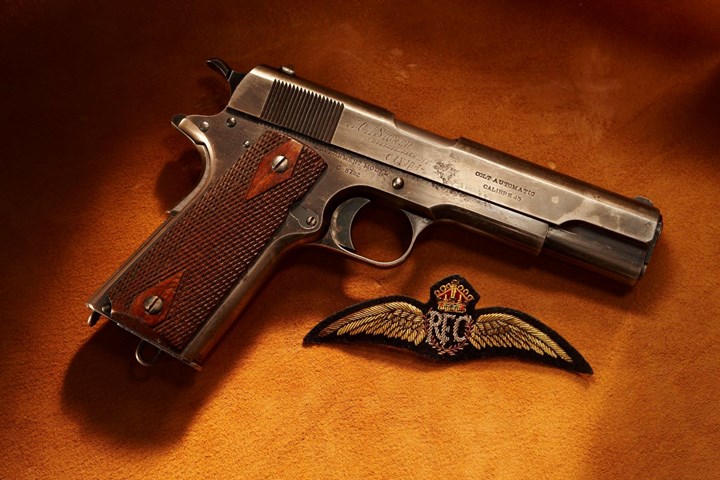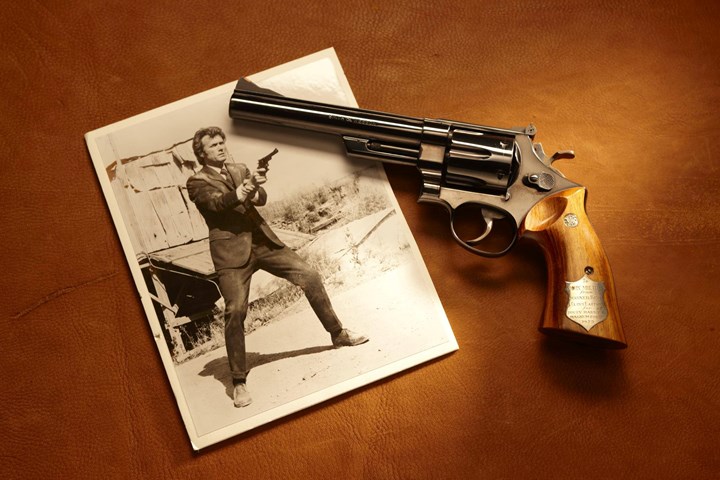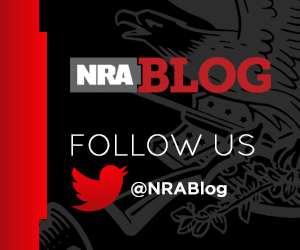Gallery

1 of 1
The Billy Club Revolver
This revolver is the classic Smith & Wesson .38 Military & Police revolver introduced, along with the .38 Special cartridge, in 1899 as S&W’s first K frame revolver. In 1957 the gun was remained to the Model 10, which it has been known as since.
Produced for more than a century, the revolver was the workhorse of Smith & Wesson's product line and featured many variations. It was arguably the predominant police sidearm of the 20th Century. This particular model is pre-WWII and has a very unique added feature – an experimental billy club attachment that fits over the muzzle. The club is hollow so the gun could even be fired with the club attached.
As far as we can tell, this device was never adopted by any law enforcement agency. Also, we can't imagine repeated impacts would be healthy for the gun's barrel.
Produced for more than a century, the revolver was the workhorse of Smith & Wesson's product line and featured many variations. It was arguably the predominant police sidearm of the 20th Century. This particular model is pre-WWII and has a very unique added feature – an experimental billy club attachment that fits over the muzzle. The club is hollow so the gun could even be fired with the club attached.
As far as we can tell, this device was never adopted by any law enforcement agency. Also, we can't imagine repeated impacts would be healthy for the gun's barrel.

1 of 1
Colt Government Model .45 Pistol
John Cameron Hume-Storer was a Canadian who joined Army ranks in 1914 and served for two years in the trenches of the Great war, hauling munitions as an officer in an ammunition train to the front lines.
A constant companion in this dangerous work was his Colt Government Model .45 pistol, inscribed by Hume-Storer, who had been a jeweler prior to enlisting. Applying for a transfer to the Royal Flying Corps in 1916, he soloed in December and as a newly promoted Captain, took off in his biplane on February 17, 1917, on a routine patrol from Ramsgate to Dover.
And that’s where the mystery comes in. Captain Hume-Storer flew into limbo on that cold, clear February morning and was never seen again. No trace of his plane’s wreckage was ever found. Yet his well-worn semi-automatic pistol was found in an American gunshop a few years ago by one of the museum’s curators. Did the Captain leave this handgun behind with a trusted friend? Or it is the only remaining clue to his mysterious disappearance?
A constant companion in this dangerous work was his Colt Government Model .45 pistol, inscribed by Hume-Storer, who had been a jeweler prior to enlisting. Applying for a transfer to the Royal Flying Corps in 1916, he soloed in December and as a newly promoted Captain, took off in his biplane on February 17, 1917, on a routine patrol from Ramsgate to Dover.
And that’s where the mystery comes in. Captain Hume-Storer flew into limbo on that cold, clear February morning and was never seen again. No trace of his plane’s wreckage was ever found. Yet his well-worn semi-automatic pistol was found in an American gunshop a few years ago by one of the museum’s curators. Did the Captain leave this handgun behind with a trusted friend? Or it is the only remaining clue to his mysterious disappearance?

1 of 1
Smith & Wesson .44 Magnum - The “Dirty Harry" Revolver
When Dirty Harry made its debut on December 23, 1971, the world clamored for the 6.5" Model 29, creating a sensation that lasted for years. But when the film's producers and director John Milius were first deciding on Harry Callahan's revolver, Milius initially wanted the longer 8.75" gun. Frank Sinatra, who was the first choice to play Harry, shuddered at the thought of the massive revolver and insisted they use a Colt Detective Special due to the lingering pain from a broken hand suffered while filming The Manchurian Candidate many years later.
After Clint Eastwood signed on, the production team sought out three Model 29's with 8.75" barrels, but none were available and they settled for the 6.5" version.
This Model 29 was presented to Milius by Warner Brothers and Clint Eastwood as a token of their appreciation for his work on Dirty Harry and Magnum Force.
After Clint Eastwood signed on, the production team sought out three Model 29's with 8.75" barrels, but none were available and they settled for the 6.5" version.
This Model 29 was presented to Milius by Warner Brothers and Clint Eastwood as a token of their appreciation for his work on Dirty Harry and Magnum Force.

1 of 1
The Apache Knuckleduster
Displayed in our curio and relic case is an authentic Belgian J. Delhaxhe Apache revolver made famous by the notorious “Les Apaches” gangs of the Parisian underworld in the late 19th and early 20th century. The piece is a true triple threat, featuring a 7mm revolving pinfire cylinder, a folding swingout blade on the backstrap and a trigger guard that doubles as brass knucks.
This style of firearm was the preferred hold-up piece for French street gangs who could easily conceal three fighting modes in one. It was the perfect bandit gun that remained menacing even when unloaded. Thankfully the piece is now on display as a historic artifact inaccessible to the back alley scoundrels and pickpockets. The advent of centerfire cartridges helped bring an end to pinfire popularity in the early 1900s.
This style of firearm was the preferred hold-up piece for French street gangs who could easily conceal three fighting modes in one. It was the perfect bandit gun that remained menacing even when unloaded. Thankfully the piece is now on display as a historic artifact inaccessible to the back alley scoundrels and pickpockets. The advent of centerfire cartridges helped bring an end to pinfire popularity in the early 1900s.

1 of 1
CSA Griswold & Gunnison Revolver
This brass frame revolver was manufactured in Griswoldville, GA between 1862 & November 1864. Manufactured in .36 caliber, there were approximately 3,700 of these percussion handguns made before Yankees burned the factory in the fall of 1864. The revolver is a loose copy of the Colt 1851 Navy in .36 caliber, with the chief difference being that the frame is made out of brass instead of steel and the barrel is round with only a segment of octagonal housing as in the Colt version.
Considered to be one of the best of the Confederate-manufactured revolvers made during the war, it is said that Griswold & Gunnison had no peer in the business. A fun and little known fact is that Samuel Griswold was originally from Connecticut and Arvin Gunnison was a native of New Hampshire. They had moved south in the pre-war years to manufacture and sell cotton gins.
Considered to be one of the best of the Confederate-manufactured revolvers made during the war, it is said that Griswold & Gunnison had no peer in the business. A fun and little known fact is that Samuel Griswold was originally from Connecticut and Arvin Gunnison was a native of New Hampshire. They had moved south in the pre-war years to manufacture and sell cotton gins.

1 of 1
The LeMat "Grapeshot revolver"
In an era when most percussion revolvers carried five or six shots of .31, .36 or .44 caliber, the LeMat was a nine shot .42 caliber revolver AND the cylinder rotated around a 16 ga. shotgun barrel!
Invented by Dr. Jean Alexander LeMat in New Orleans in 1856, fewer than 3,000 were ever manufactured; primarily in Europe, although a few were made in Philadelphia. A number slipped through Union blockades to arm the Confederacy during the Civil War and saw use by both Gen. J.E.B. Stuart and Gen. Beauregard.
While many gun enthusiasts are familiar with the percussion LeMat, it is less widely known that limited numbers of the gun were also produced chambered for pinfire and centerfire cartridges.
Invented by Dr. Jean Alexander LeMat in New Orleans in 1856, fewer than 3,000 were ever manufactured; primarily in Europe, although a few were made in Philadelphia. A number slipped through Union blockades to arm the Confederacy during the Civil War and saw use by both Gen. J.E.B. Stuart and Gen. Beauregard.
While many gun enthusiasts are familiar with the percussion LeMat, it is less widely known that limited numbers of the gun were also produced chambered for pinfire and centerfire cartridges.

1 of 1
Chicago Firearms "Protector" Palm Pistol
This unusual model was made to be fired while concealed in the palm of the hand with the barrel projecting through the clenched fingers. The small lever above the barrel serves as a safety, and the gun is fired by squeezing the large lever on the back with the palm of the hand (base of the thumb) in the closed fist.
Around 13,000 of these were made in the 1890s. A disk like steel magazine has chambers arranged like the spokes of a wheel, with the cartridges pointed outwards. With each squeeze, a new round rotates into position behind the barrel and is fired. It chambers a special extra short .32 rimfire round. There are no sights, so close proximity was required for accuracy.
Around 13,000 of these were made in the 1890s. A disk like steel magazine has chambers arranged like the spokes of a wheel, with the cartridges pointed outwards. With each squeeze, a new round rotates into position behind the barrel and is fired. It chambers a special extra short .32 rimfire round. There are no sights, so close proximity was required for accuracy.

 More Like This From Around The NRA
More Like This From Around The NRA



